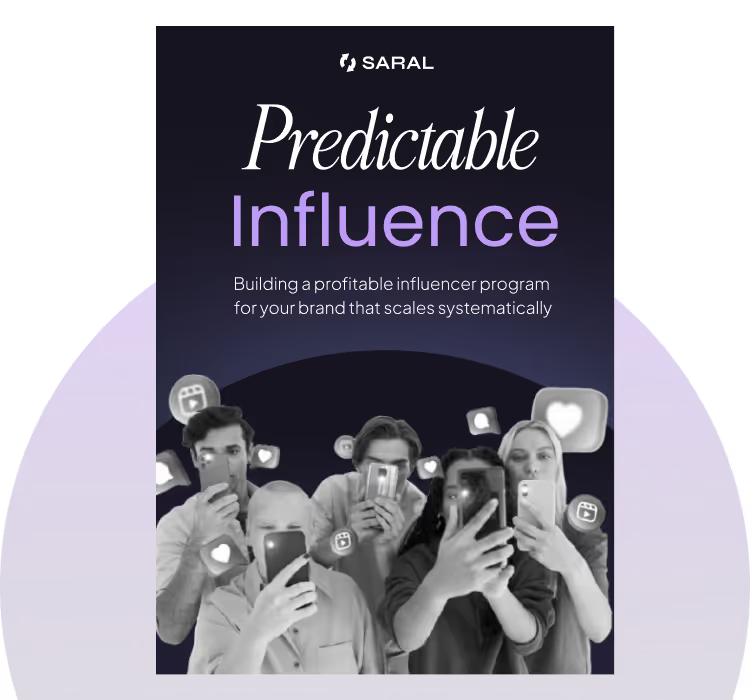Ready to drive incremental growth with influencers?
If ditching the randomness of influencer campaigns and building a predictable, ROI-first influencer program sounds like a plan. Consider talking to our team!

Affiliate Marketing
Discover how to evaluate your profits, brand story, target buyers, partner support, and tracking tools before starting affiliate marketing for your brand.
Contents
If you're a DTC brand, affiliate marketing seems like an obvious move.
But having a solid product and some software to generate tracking links is nowhere near enough.
Even though creators and influencers will be working hard on your behalf, you need to do a lot of homework to make sure they're successful.
This guide breaks down the non-negotiable elements your brand needs before affiliate marketing can become a reliable revenue channel rather than another disappointing marketing experiment.
But you can't determine if you're ready for something if you're not even clear on what that something truly is. So, let's clear the outdated definition of affiliate marketing.
Affiliate marketing means someone promoting your products using a unique link and earning a commission on the sales that come from that link. This is a transactional view. It misses the strategic depth that makes modern affiliate programs successful, especially for direct-to-consumer brands.
While that transactional foundation remains, today's successful DTC brands approach affiliate marketing as relationship-building rather than transaction-generating. They invest in:
When affiliates feel truly connected to your brand:
These customers stick around. They become loyal to your brand because they connected with your values, not just your promo code.
Check out this video 👇to know the step-by-step process of how to create an affiliate program that drives revenues, and not just likes.
Go through these questions, and check how to evaluate your situation before going ahead with affiliate marketing.
The first requirement for a successful affiliate program is positive unit economics. Your products must generate profit after accounting for all costs, including the additional 10-15% commission you'll pay to affiliates, AND the discount that affiliates will offer to their audience.
When you add affiliate commissions to already thin margins, you create unsustainable pressure on your business model. This leads to three problematic outcomes:
The "growth at all costs" strategy doesn't work here.
Positive profit margins allow you to incentivize top-performing affiliates by increasing their commissions over time, keeping them motivated and engaged. If your margins are too tight, affiliates will eventually feel they're not growing with your brand and may leave for more lucrative opportunities.
Without clarity on what makes your brand different, affiliates default to promoting discounts rather than differentiation. This trains consumers to value your products only when discounted, eroding your margins and brand perception.
Even worse, they may misrepresent your brand, attracting customers with expectations you can't meet. Without proper guidance, affiliates often make exaggerated claims about benefits, compatibility, or performance. These misalignments lead to returns, negative reviews, and customer service burdens that damage both your reputation and the affiliate relationship.
If you're thinking… "We already have brand guidelines and a website—isn't that enough documentation for affiliates?"
No.
You don't want to simply hand affiliates a list of product features and let them create any narrative they choose. A successful affiliate program requires a single, consistent value proposition being repeated across social media multiple times. This repetition creates a continuous impact and reinforces your brand message.
Here’s a practical test to see if you know your brand's value proposition:
Can you explain in one sentence why specific customers should buy from you instead of competitors? Can you identify the exact type of customer who benefits most from your unique attributes? If these answers aren't crystal clear, your affiliates will struggle to create compelling, accurate content.
If you don't know who your target audience is, you won't know who can effectively influence them. The best affiliate partners are those who already have credibility with your exact target market.
Many brands approach affiliate marketing with vague audience definitions like "health-conscious women" or "tech enthusiasts," which are far too broad to identify the right partners.
What most brands miss is that your customers often trust people who don't look like them but think like them. Just because a creator matches your customer's age, gender, or location doesn't mean they have influence over them. Your audience follows people who share their values, goals, and worldview, not just their demographic profile.
For instance, a sustainability-focused skincare brand might find better affiliate performance with climate activists than beauty influencers, despite the latter seeming more category-relevant.
Successful programs require granular audience understanding that goes beyond basic demographics to include:
Without this detailed knowledge, brands waste resources pursuing partnerships with creators who have large followings but minimal influence over their actual buyers. This results in high upfront costs (product samples, free access, partner time) with minimal conversion.
The most common misconception in affiliate marketing is that it's a "set it and forget it" channel. But successful affiliate programs require consistent relationship management, not just technical administration.
Popular creators get offers from brands every day. They can quickly tell which companies just want to use them for sales versus those who value them as real partners. When you treat creators like they're nothing special and only message them about sales numbers, they notice, and they move on to other brands.
What makes this challenging is the gradual nature of relationship degradation.
Neglected affiliates don't immediately stop promoting your products—they simply reduce frequency, enthusiasm, and creativity in their promotions. They save their best placement opportunities and most compelling content for brands that actively engage with them.
Brands often underestimate the time required for these activities, assigning affiliate program management as a minor responsibility to already-overloaded team members. When relationship-building activities inevitably get deprioritized, program performance gradually declines.
This is the most basic requirement for running an affiliate program: accurately tracking which sales come from which influencers. This cannot be managed with spreadsheets or unreliable free software. Those approaches inevitably lead to missing sales, incorrect attributions, and payment disputes.
When tracking fails, two costly problems occur:
An influencer marketing platform like SARAL solves these problems by offering:
Step 1: Go to Settings → General and create a new Discount Code Template using the "USERN" or “FIRSTN” format (automatically uses the creator's username).

Step 2: Enable "Single Use Per Customer" and "New Customers Only" restrictions to prevent code sharing.
Step 3: Set a minimum order value to protect against low-value redemptions.

Step 4: Access your affiliate's profile from the Relationships board.
.png)
Step 5: Click "Generate Discount Code," select your leak-proof template, and click "Generate."

Step 6: Generate a unique tracking link for the same affiliate to ensure both code and link attribution.
Step 7: Monitor usage patterns in SARAL's dashboard to spot any unusual redemption activity that might indicate leakage.
You're in an excellent position to launch a successful affiliate program…
Affiliate marketing offers significant advantages over traditional advertising methods - it's performance-based (you only pay for results), builds authentic relationships with promoters who genuinely believe in your products, and often delivers higher ROI than expensive billboards, TV commercials, or digital ads that many DTC brands default to.
But don't be discouraged….
Most of these elements can be developed within a few weeks or months. You can refine your value proposition, improve your profit margins, create marketing materials, or implement proper tracking systems relatively quickly. Your commitment to building and nurturing relationships with quality affiliates is the most important factor.
Talk to the team at SARAL and see how we can help you overcome your obstacles quickly. Our platform can help you find, and manage affiliates for your brand.

Sign up for a 7-day email course on the unique "Predictable Influence" strategy used by top brands like Grüns, Obvi, Tabs Chocolate.

Kim Biddle, Co-Founder of Clutch Affiliate, shares real examples from her experience managing affiliate programs for CPG brands and provides actionable insights for both emerging and established brands.

If ditching the randomness of influencer campaigns and building a predictable, ROI-first influencer program sounds like a plan. Consider talking to our team!